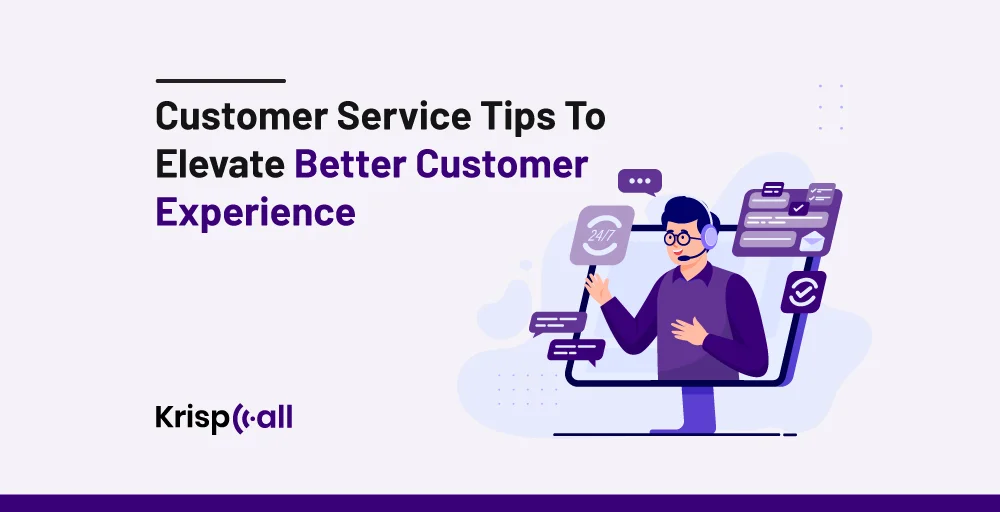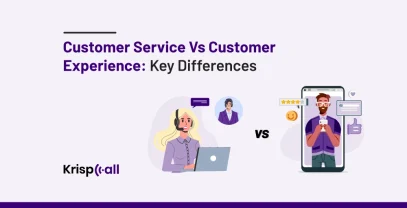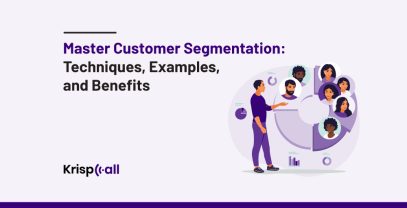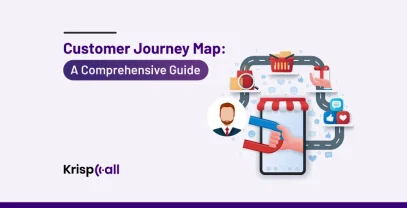Most of us have interacted with a customer service representative who seemed too bored 🥱 to talk and even lacked courtesy at least once in our lives.
How was that experience 🤔? It’s probably not very enjoyable.
However, Increasing investment in customer care is not a new thing for a company to thrive, but providing remarkable support with high-quality customer service is critical to gaining customer loyalty and boosting sales.
Numerous techniques and methods that companies adopt can create superb experiences and customer excellence. This blog will detail 16 Customer Service Tips. So, Let’s begin.
🔑 KEY HIGHLIGHTS
- Customer service is pivotal for a company to thrive and provide remarkable support.
- Empathy is not just a skill but also essential for positive communication and leads to happier customers who want to keep doing business with you.
- Prioritize first-call resolution to solve issues in one interaction fully.
- Personalize interactions by customizing experiences for each individual customer.
- Anticipate customer needs by sensing issues proactively and offering help beforehand.
16 Best Customer Services Tips to Start Implementing Today
Delivering better customer service is the primary goal of many businesses. By following the below tips, you can easily improve customer retention rates:
1. Understand And Empathize
Building good relationships with customers over the phone is really important for providing good service and increasing sales. No matter why customers contact you, whether about an issue or complaint, your role is to ensure they feel listened to, respected, and understood.

Responding to a customer’s concerns shows that you understand how they feel and what they are going through. This is very important for good communication and customer service.
Managers need to keep reminding their teams to see things from the customer’s point of view. Then, they will be able to make the customer’s issues their own and meet the customer’s expectations.
Active listening, showing empathy in your responses, and genuinely caring for customers help build rapport and solve issues better. Empathy is not just a skill; it is essential for positive communication and leads to happier customers who want to keep doing business with you.
Additionally, sending a gentle reminder to follow up on unresolved issues can help ensure that customers feel valued and their concerns are being addressed promptly.
2. Utilize Optimistic Language
When a customer is upset, the first thing to do is apologize. Start by saying, “I’m sorry for the problem,” before explaining why you contacted them.
Why do that? Because using nice words is essential in customer service. This flows the conversation in a positive direction. ➡️
A study found that more than 86% of shoppers said they’d pay extra for nicer service. Using nice words is important because it makes people feel welcome. How someone says something – makes a big difference.
3. Connect Clearly With Clients
Many customer service workers struggle with communication for different reasons. Some rely too much on scripts full of hard-to-understand language instead of just talking.
Others mumble or talk too fast for customers to follow along. Some don’t listen carefully enough to fully grasp a customer’s problem before responding. Unclear or confusing messages can easily frustrate customers and damage the relationship.
Therefore, Clear communication is important to build trust and a good bond between customer and business. To promote clear talking at your company, check any pre-written responses to ensure the words are simple and easy to understand. Employees should also get guidance on speaking plainly and avoiding complex vocabulary with customers.
Additionally, do training on active listening. Teach workers how to pay close attention to understand all details of an issue before answering. This prevents reps from giving unclear information that may confuse customers.
4. Be Knowledgeable About Your Products & Services.
Gaining product knowledge means teams learning details about a company’s products so they can correctly describe them to shoppers.
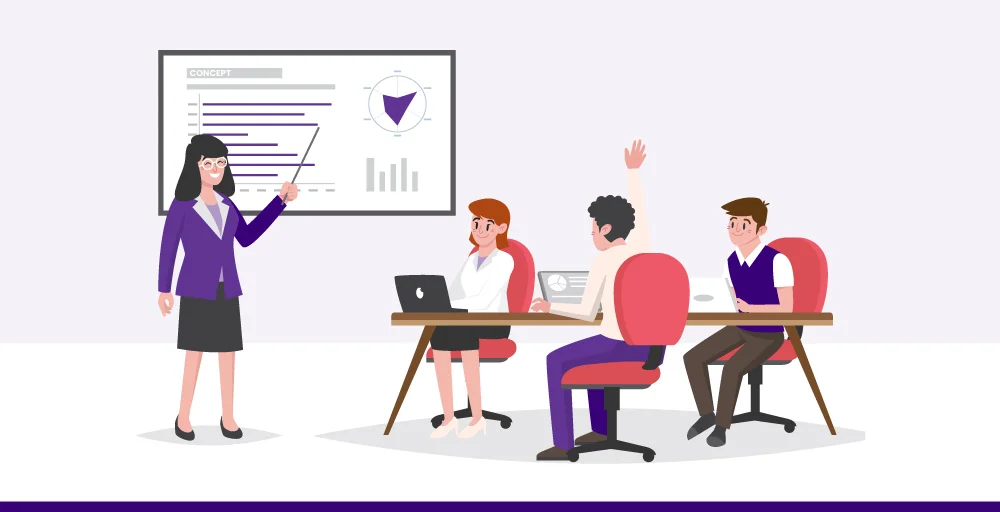
It involves people who interact with customers, understanding specifics about product features and advantages and how they can help. They may also learn about fixing problems and providing guidance so they can aid customers with any issues.
With this information, sales and assistance teams can help customers feel good about what they bought and want to do business with the company again. This helps ensure satisfied and loyal repeat buyers.
5. Prioritize First-call Resolution.
Finishing customer issues fully and permanently during the first contact leads to higher satisfaction and a positive company image.
However, unsolved requests that get passed around between departments reduce trust and loyalty. Workers usually focus on one area and send overflow problems elsewhere. This splitting up inevitably causes customer frustration.
To include more complete troubleshooting in initial interactions, train frontline agents and equip them with tools to solve various common questions. Implement better documentation and information sharing between teams. Create an easily searchable database where agents can access details on specialized topics handled elsewhere to address more parts of customer problems.
Regularly checking and rating customer interactions also helps monitor first-call resolution rates. Providing extra coaching and cross-training for low scorers expands their abilities to unify service over time. This will help resolve issues more completely the first time.
6. Establish Suitable Expectations.
Simply put, customer expectations are what they think they will get from a company they deal with.
It could be something basic like getting a product or maybe something you can’t see or touch, like a smile from the cashier or a nice person on the phone.
Proactively setting what customers expect helps predict any issues they may have and makes sure that the problems are fixed before they happen. This leads to customers being more loyal and trusting.
When companies are clear about what customers will experience, it prevents bad service and keeps them happy.
7. Personalize Customer Interactions
Personalized customer experience means treating each customer with special treatment through messages, deals, suggestions, and more.
It sees customers as unique individuals with their own likes and dislikes instead of just part of a group. The key is customizing everything a customer sees, not just giving generic product ads or form emails.

Personalization uses what is known about customers to change what they see at every step, sometimes making the experience better than previous times.
It might include a special webpage based on where someone lives or item picks based on past buys to an individual meeting. The experience is designed just for them and to make them feel that the company knows them and wants to offer them an experience suited just for them.
8. Anticipate Customer’s Wants
Anticipating customer needs means being proactive with customer service: you sense a customer may need help, so you contact them first instead of waiting for them to call support.
This kind of reaching out before being asked is not just a nice bonus – customers expect it now. 70% of people view companies more positively if they get notices offering help before problems happen.
Giving better customer service is good, but fixing issues without being asked is even better. It shows customers you care enough to go above and beyond to improve their experience and makes them like your brand more.
Website usage numbers, past support chats, and user testing give a goldmine of customer data. This lets you catch possible issues customers might run into and help them without waiting to be asked.
The better you are at predicting needs, the better you’ll get at preventing customer problems altogether.
9. Go Above & Beyond
Going above and beyond for customers is often what makes good customer service great.
Things like checking in on a problem even after it’s solved, coming up with creative fixes when nothing obvious works, sincerely apologizing for troubles not caused by the company, or providing extra information and learning tools more than asked can show the customer you care.
Letting representatives have the flexibility and power to make these judgment calls leads to stronger relationships and, when suitable, the retention of customers.
Of course, context and reason matter. Following up repeatedly if there is no response or going overboard to fix small issues has limits.
However, reasonably doing more than is strictly needed, as it often reminds customers that the company values them. These gestures stick in memories linked to positive feelings toward the brand.
10. Maintain a Positive Attitude
Having a positive attitude in customer service (and life) spreads and really impacts people in a good way. Service teams can guide customer behavior and influence them more easily by staying positive.
Staff needs to focus on good interactions and positive parts of customer relationships, not just some negative ones. Maintaining a positive outlook sets the tone for all customer conversations, which rubs off on customers too.
The truth is that focusing only on angry, annoyed, or yelling customers from work makes workers dread the next day and hate their jobs. These bad attitudes grow, and staff may become rude or defiant.
A positive outlook prevents this snowballing and helps teams shape customer experience positively.
11. Seek Customer Feedback.
Customer feedback is customer information about their experience with a product or service. Its goal is to show how satisfied they are and help customer support, business products, and marketing teams know what types of improvement are needed.

Companies can actively collect feedback by asking customers questions through polls, surveys, or interviews. Teams also gather feedback passively when they give users a spot in the product/service to share comments, complaints, or compliments freely.
If companies don’t get customer feedback, they will never know if people find value in what they offer. Without knowing about value, product and sales teams won’t be able to tell if they are creating loyal repeat customers or be able to measure customer retention. Thus, Customer feedback is crucial for business success.
12. Focus on Continuous Learning
Teams need constant education on new products, policies, processes, and systems the company offers. As customer needs and wants change, reps also need to expand their skills in communication methods, conflict handling, emotional skills, and problem-solving.
Managers can encourage ongoing learning with guidance, training workshops, and highlighting a mindset focused on growth.
Having a staff that is always improving leads to superior interactions and a stronger brand reputation in the long run from steady, excellent customer service. As employees and customers evolve, constant learning keeps service teams equipped to meet changing needs.
13. Celebrate Achievements
Celebrating customers’ good behavior is one of the most effective ways to increase product use and strengthen bonds with customers.
However, many customer success managers overlook this simple tactic. This is partly because the urgency to save struggling customers takes all the focus. Teams often just concentrate on problems and forget successes.
When working with customers, remembering gratitude goes a long way. Recognizing them builds confidence in the product and an understanding of its worth. Customers are likelier to point out flaws rather than focus on progress without positive feedback.
Since praise costs nothing to give and has huge potential, it’s a valuable way to invest that all CSMs can use emotionally. Taking time to celebrate wins pays off in deepening relationships and driving adoption.
💡 You May Also Like: KrispCall’s Customer Reviews
14. Dedicate Resources To Customer Service Skills
Customer service can make or break your business. For many people, how they are helped is one of the biggest things affecting if they keep buying from a brand. 90% of Americans consider customer service when deciding.
Research shows that 86% of consumers will stop engaging with a brand they previously trusted after just two bad customer experiences. In other words, bad customer service could lose customers.
While bad service can slow growth, where a good service can be hugely beneficial. Most consumers are likely to pay a higher price for products and services from companies known for providing excellent customer service experiences.
Good customer service is vital—it determines whether people continue to do business with you or go to competitors.
15. Welcome Technological Advances
Use tools and platforms that let your customer support team improve response times with modern communication tools & services. For example, many customers now prefer self-help options like web chatbots for quick questions instead of face-to-face talks.

Feeling fully comfortable with critical systems for accessing customer information empowers faster service. Technology solutions like ticket systems, cloud phone systems with screen-sharing capabilities, and file transfer options help interactions run smoothly.
Equipping chatbots to handle basic requests frees up people for tougher issues. Data analysis through AI also provides insights into emerging needs. When tech does repetitive tasks, reps can focus on building relationships.
Resources like online help sections and FAQs cuts down research time for common questions.
🔥 But don’t rely too much on automatons. Use them where helpful and as needed.
16. Track Your Customer Service Metrics
Customer service metrics are valuable because they provide organizations with a useful understanding of the effect, success, and overall quality of the customer experience.
With these metrics, companies can tell what’s working well and what needs improvement. Consistently positive customer feedback shows the support provided is helpful so they should focus on keeping it up.
However, regular negative social media comments or a high number of ticket reopenings may indicate problems with the product, procedures, or self-help options. This type of data helps pinpoint where changes are required.
Tracking metrics gives businesses insight to maintain strong customer experience and make adjustments where needed. It helps maximize success and minimize issues customers face.
Conclusion
Customer service, without a doubt, is one of the key aspects of a successful business organization. From proper knowledge about the product to showing empathy and understanding, it plays a crucial role in maintaining the image of a business, especially in the long run.
Even though business executives think their customer service is exceptional, the reality is far from what they imagine. There is still much more to learn, such as emotional intelligence training, conflict resolution, and cultural awareness. These skills help them fully comprehend customer requirements, effectively handle their problems, and provide remarkable customer service interactions.
Nevertheless, Opportunities still remains to dive deeper.

